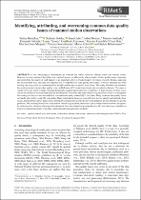Mostrar el registro sencillo del ítem
Identifying, attributing, and overcoming common data quality issues of manned station observations
| dc.contributor.author | Hunziker, Stefan | |
| dc.contributor.author | Gubler, Stefanie | |
| dc.contributor.author | Calle, J. | |
| dc.contributor.author | Moreno, Isabel | |
| dc.contributor.author | Andrade, Marcos | |
| dc.contributor.author | Velarde, Fernando | |
| dc.contributor.author | Ticona, Laura | |
| dc.contributor.author | Carrasco, Gualberto | |
| dc.contributor.author | Castellón, Yaruska | |
| dc.contributor.author | Oria, Clara | |
| dc.contributor.author | Croci-Maspoli, M. | |
| dc.contributor.author | Konzelmann, Thomas | |
| dc.contributor.author | Rohrer, M. | |
| dc.contributor.author | Brönnimann, Stefan | |
| dc.date.accessioned | 2019-09-20T01:07:11Z | |
| dc.date.available | 2019-09-20T01:07:11Z | |
| dc.date.issued | 2017-03-20 | |
| dc.identifier.govdoc | Perú | |
| dc.identifier.uri | https://hdl.handle.net/20.500.12542/151 | |
| dc.description.abstract | In situ climatological observations are essential for studies related to climate trends and extreme events. However, in many regions of the globe, observational records are affected by a large number of data quality issues. Assessing and controlling the quality of such datasets is an important, often overlooked aspect of climate research. Besides analysing the measurement data, metadata are important for a comprehensive data quality assessment. However, metadata are often missing, but may partly be reconstructed by suitable actions such as station inspections. This study identifies and attributes the most important common data quality issues in Bolivian and Peruvian temperature and precipitation datasets. The same or similar errors are found in many other predominantly manned station networks worldwide. A large fraction of these issues can be traced back to measurement errors by the observers. Therefore, the most effective way to prevent errors is to strengthen the training of observers and to establish a near real-time quality control (QC) procedure. Many common data quality issues are hardly detected by usual QC approaches. Data visualization, however, is an effective tool to identify and attribute those issues, and therefore enables data users to potentially correct errors and to decide which purposes are not affected by specific problems. The resulting increase in usable station records is particularly important in areas where station networks are sparse. In such networks, adequate selection and treatment of time series based on a comprehensive QC procedure may contribute to improving data homogeneity more than statistical data homogenization methods. | en_US |
| dc.format | application/pdf | |
| dc.language.iso | eng | en_US |
| dc.publisher | John Wiley and Sons Ltd | en_US |
| dc.relation.ispartof | urn:issn:1097-0088 | |
| dc.rights | info:eu-repo/semantics/openAccess | en_US |
| dc.rights | Atribución-NoComercial-SinDerivadas 3.0 Estados Unidos de América | * |
| dc.rights.uri | http://creativecommons.org/licenses/by-nc-nd/3.0/us/ | * |
| dc.source | Repositorio Institucional - SENAMHI | en_US |
| dc.source | Servicio Nacional de Meteorología e Hidrología del Perú | en_US |
| dc.subject | Climatología | en_US |
| dc.subject | Data rescue | en_US |
| dc.subject | Error attribution | en_US |
| dc.subject | Quality control | en_US |
| dc.subject | Análisis de Datos | en_US |
| dc.title | Identifying, attributing, and overcoming common data quality issues of manned station observations | en_US |
| dc.type | info:eu-repo/semantics/article | en_US |
| dc.identifier.isni | 0000 0001 0746 0446 | |
| dc.description.peerreview | Por pares | |
| dc.identifier.doi | https://doi.org/10.1002/joc.5037. | |
| dc.identifier.journal | International Journal of Climatology | |
| dc.subject.ocde | https://purl.org/pe-repo/ocde/ford#1.05.10 | |
| dc.subject.sinia | datos y estadisticas ambientales - Gestión, Fiscalización y Participación Ciudadana Ambiental | |
| dc.type.sinia | text/publicacion cientifica | |
| dc.identifier.url | https://hdl.handle.net/20.500.12542/151 |
Ficheros en el ítem
Este ítem aparece en la(s) siguiente(s) colección(es)
-
Artículo científico [171]









